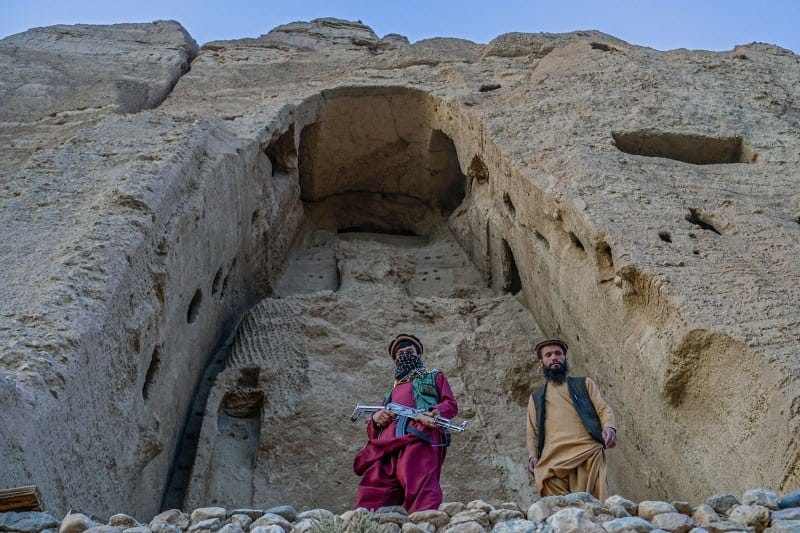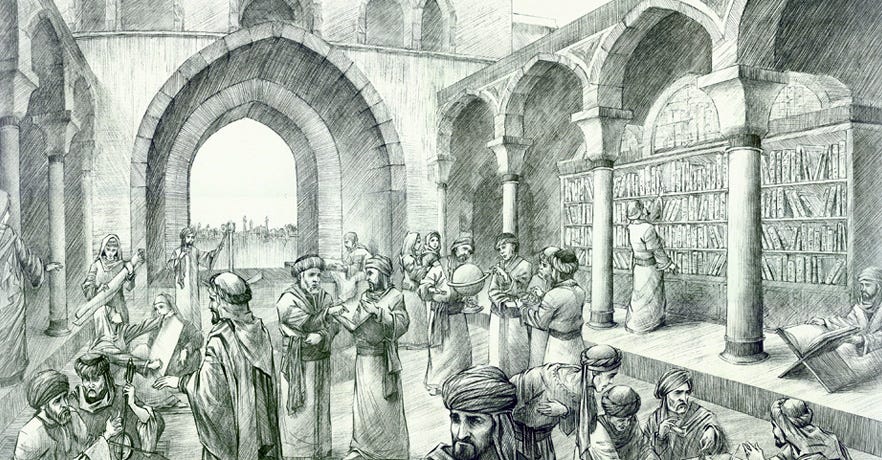I was watching a fictional series over Easter that centred around the discovery of a buried temple in Iraq from thousands of years ago. Why Iraq? Well I’m glad you asked! You see the Golden Age of mathematics is generally associated with the 3rd century BC in ancient Greece, and the 8th to 14th centuries in the Islamic world. While Greek mathematics saw significant advancements in the 3rd century BC, the Islamic Golden Age built upon and extended these advancements, making further contributions in various fields.
From the 8th to the 14th century, the Islamic Golden Age of Science was a time of outstanding academic, cultural, and scientific advancements. Islamic scholars made significant contributions to many areas of knowledge during this time. It covered astronomy, chemistry, physics, philosophy, medicine, and arithmetic.
Mathematicians like Al-Khwarizmi, credited with formalising algebra, and Omar Khayyam, known for his work in algebraic calculus, made fundamental contributions.
Key advancements included the introduction of the Hindu-Arabic numeral system, which revolutionised arithmetic and calculation.

In the ninth century, Harun al-Rashid, the ruler of the Abbasid Empire, established the House of Wisdom in Baghdad. It was a gathering place for academics from various backgrounds and religions to exchange ideas and information. The vast library of the House of Wisdom was filled with books and manuscripts from all over the globe, including works by Greek, Roman, Persian, and Indian authors.
The Islamic Golden Age of Science was a remarkable period in human history that saw an explosion of scientific, philosophical, and artistic creativity. However most importantly, the Islamic Golden Age of Science was marked by a spirit of intellectual curiosity and openness to new ideas, allowing scholars of different cultures and faiths to collaborate and exchange ideas.
So what in the Jahannam happened? Where did Islam go so wrong?
In March 2001, the Taliban destroyed the two monumental Buddha statues carved into the cliffs of the Bamiyan Valley in central Afghanistan. These statues, known as the Buddhas of Bamiyan, were built in the 6th century and were considered masterpieces of early Buddhist art.

Now for around $5, curious visitors can wander around and take photos of the giant holes in the cliff face where the ancient Buddha statues once stood. Under a white Taliban flag, militants man a booth and write out admission tickets.
in March 2015, when the terrorist group ISIS deliberately destroyed the ancient Assyrian city of Nimrud the using bulldozers, sledgehammers, and explosives.
Nimrud flourished during the 9th century BCE and was one of the capitals of the Neo-Assyrian Empire. The site included remarkable examples of Assyrian art and architecture, including massive palace complexes, lamassu statues (human-headed winged bulls), intricate stone reliefs, and temples. ISIS erased it.
The destruction of cultural heritage is of course a violation of human rights, except when brown people or Muslims do it, then its racist to call it out.
Where as once Islam was admired and revered for their academic excellence and thirst for new knowledge, Islam today is characterised by censorship, authoritarianism, stifling dogmatic rules and terrorism.
Muslims, who once stood at the forefront of knowledge in the 11th century, now find themselves at the bottom of the global intellectual hierarchy.
Some historians have blamed the Mongol attack on Baghdad (1258 CE), which destroyed universities and killed many scholars. Some blamed colonialism as another significant reason. Rarely however can such significant cultural shifts however be blamed on isolated incidences.
Although these events may have contributed, the main cause of the decline was the theologians’ opposition to studying philosophy and science as they were concerned that it would weaken the faith.
So they traded knowledge for dogma.
Another major factor was that the Suljuk Caliphs, who took power from Abbasids, believed that educated people would demand democracy and they would lose control.

The caliphs withdrew their support of excellent universities, and Nizam-ul-Mulk1 changed the curriculum to Islamic studies in all the universities.
By the 15th century, no university in the Muslim world was teaching science and philosophy and published very little scientific work.
And we in the 21st century are now living with the consequences.
1.7 billion Muslims living in 57 Muslim-majority countries constitute 25% of the world population. Yet, Muslims have only 1% of all scientists and 6% of scientific publications. Muslims spend 0.5% of GDP on research and development vs. 10% of spending by Western countries. The literacy rate is 40% in Muslim countries vs. 90% in the Western world. The Muslim world has 500 scientists and technologies per million population vs. 5000 per million in Western countries.2
The great Muslim scholars of the medieval years did not see any dichotomy between religion and science, motivated by the pursuit of knowledge and the progress of humanity. It's deeply tragic that Islam has been corrupted by fear and dogma, resulting in a distorted version that is taught to billions around the world.
If the medieval period was knows and the Islamic Golden Age, the 21st Century will surely be knows as the Islamic Age of Terror, or maybe the Islamic Dark Ages — billions of women restricted from basic education, millions of children taught nothing else but the Quran and Hadiths. Fear, ignorance, intolerance, shame, hate, violence and terror.

It would be easy to point to obvious factors such as authoritarianism, bad education, and ongoing conflict to explain the steep decline, but it glosses over the most important factor. Today’s version of Islam does not allow for critical thinking or free enquiry. It pits faith against reason and has no distinction between religion and politics.
There is a final reason why it makes little sense to exhort Muslims to their own past: while there are many things that the Islamic world lacks, pride in heritage is not one of them. What is needed in Islam is less self-pride and more self-criticism.3
Ironically while Islam continues to be highly critical of the West and of non-believers they fail to admit that their own glaring short-comings are largely internal. They have created a culture of self-pity and blame which has become their biggest obstacle to progress and self-correction. It’s time Muslims start having these conversations and asking themselves the big questions. If Islam is so great, why are so many muslim-majority countries such failures?
References:
https://www.historyadventures.co/the-islamic-golden-age-an-inspiring-tale-of-science-art-and-philosophy/
https://www.theguardian.com/world/2014/sep/29/schoolgirl-jihadis-female-islamists-leaving-home-join-isis-iraq-syria
https://islamichorizons.net/the-decline-of-the-pursuit-of-knowledge/
https://www.thenewatlantis.com/publications/why-the-arabic-world-turned-away-from-science
https://islamicvoice.com/religion/the-decline-of-the-pursuit-of-knowledge/
https://wisconsinmuslimjournal.org/https-americanmuslimtoday-com-details-fcdfb80f-7f73-4677-9f51-0c674ead1c3c/
https://en.wikipedia.org/wiki/Nizam_al-Mulk
https://islamichorizons.net/the-decline-of-the-pursuit-of-knowledge/
https://www.thenewatlantis.com/publications/why-the-arabic-world-turned-away-from-science






Sensitively written and very interesting. Thank you.
It's definitely a problem with Islam. An attack yesterday involved the Islamic terrorist seperating Muslim from non Muslim before killing the non Muslim civilians in cold blood.